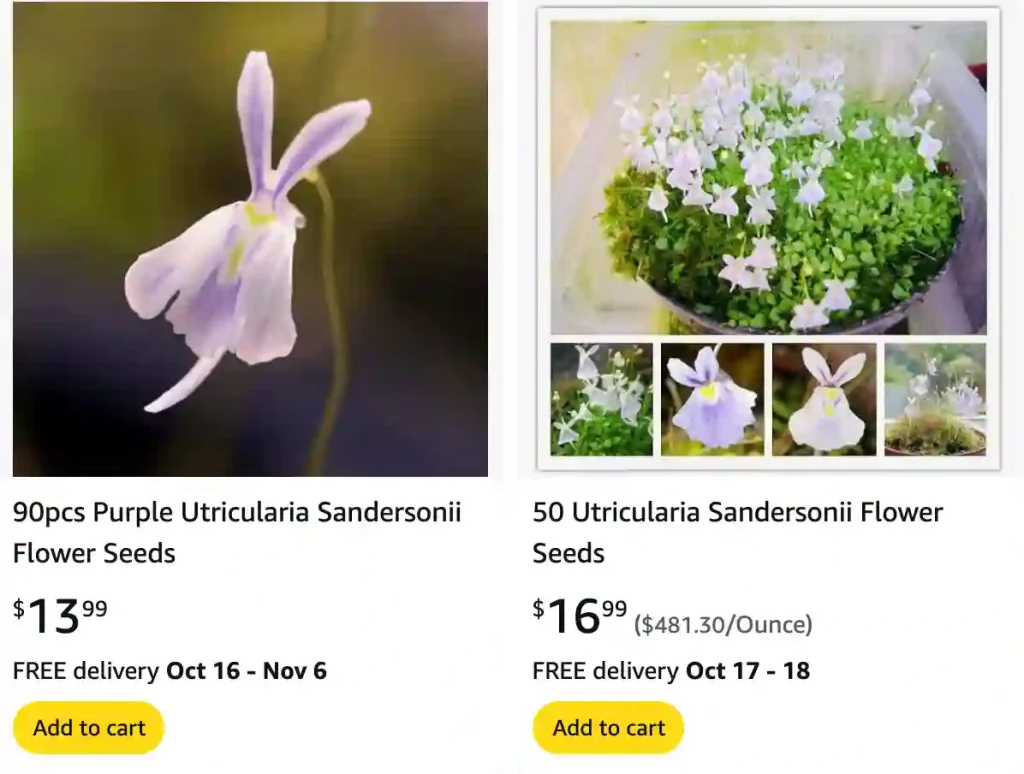
FAQs About Utricularia Sandersonii
When I first encountered Utricularia Sandersonii, I was intrigued by its unique appearance and curious about how to care for it. This fascinating plant, often known as the Sanderson’s Bladderwort, is a type of carnivorous plant that can add a touch of the exotic to any garden. Here, I’ll share everything I’ve learned about Utricularia Sandersonii, addressing the most common questions and concerns I’ve come across.
287 Species in Genus Utricularia
What is Utricularia Sandersonii?
Utricularia Sandersonii is a small, carnivorous plant belonging to the bladderwort family. It’s native to South Africa and is well-known for its intriguing trapping mechanism. Unlike many other carnivorous plants that rely on sticky traps or pitfall traps, Utricularia Sandersonii uses tiny, bladder-like traps to capture and digest small prey. These traps, called utricles, are submerged in the soil or water and function much like tiny vacuum cleaners, drawing in unsuspecting insects.
How to Care for Utricularia Sandersonii?
Caring for Utricularia Sandersonii can be a bit of a challenge, but it’s definitely rewarding. Here are the key points I’ve found useful:
- Light: This plant thrives in bright, indirect light. If grown indoors, place it near a window where it can get plenty of filtered sunlight. Outdoors, it prefers a spot with partial shade to mimic its natural habitat.
- Water: Utricularia Sandersonii prefers pure, distilled water. It’s sensitive to tap water, which can cause damage. Keep the soil or growing medium moist but not waterlogged. If you’re growing it in a terrarium or a pot with standing water, ensure the water level doesn’t dry out.
- Soil: Use a well-draining, acidic soil mix. A blend of sphagnum moss and perlite works well. Avoid using regular potting soil, as it can be too rich in nutrients.
- Temperature and Humidity: This plant prefers temperatures between 60-80°F (15-27°C) and high humidity. If you’re growing it indoors, a terrarium or a humidified environment is ideal.
How to Propagate Utricularia Sandersonii?
Propagating Utricularia Sandersonii can be a bit tricky but is definitely possible. The most common method is through division:
- Division: Gently separate the plant into smaller sections during the growing season. Each section should have roots and a few leaves. Re-pot these sections into new containers with fresh growing medium.
- Seeds: You can also propagate via seeds, though it requires patience. Sow the seeds on a moist, acidic medium and keep them in a warm, humid environment. Germination can take several weeks.
What to Plant with Utricularia Sandersonii?
If you’re thinking of creating a mini ecosystem, Utricularia Sandersonii pairs well with other carnivorous plants such as Sarracenia (pitcher plants) or Drosera (sundews). Their similar care requirements make them great companions. Additionally, incorporating mosses like sphagnum can help maintain the necessary humidity levels.
Is Utricularia Sandersonii Toxic?
No, Utricularia Sandersonii is not toxic. It’s a non-venomous plant that captures insects for nutrition, not for defense. It’s safe to handle, though you should always wash your hands afterward, just in case you’ve come into contact with any soil or growing medium.
Benefits of Utricularia Sandersonii
One of the main benefits of Utricularia Sandersonii is its ability to control pests. Its unique trapping mechanism helps keep small insect populations in check, which can be particularly useful in a garden setting. Additionally, its unusual appearance can make it a fascinating conversation piece and a beautiful addition to any plant collection.
Common Problems with Utricularia Sandersonii
Despite its unique charm, Utricularia Sandersonii can face some issues:
- Root Rot: Overwatering or using non-sterile soil can lead to root rot. Ensure the growing medium is well-draining and the plant isn’t sitting in stagnant water.
- Poor Growth: If the plant isn’t growing well, check for insufficient light or incorrect water quality. Ensure it’s getting enough indirect light and that you’re using distilled water.
- Pest Infestation: While rare, pests like aphids or fungus gnats can occasionally affect Utricularia Sandersonii. Regularly check for pests and address any infestations promptly.
Compare with Other Similar Plants
Utricularia Sandersonii is often compared to other bladderwort species, like Utricularia Graminifolia or Utricularia Gibba. While they all share the characteristic bladder traps, Utricularia Sandersonii is notable for its unique growth habit and smaller, more delicate traps. It also differs in its habitat preferences and care requirements compared to other bladderworts.
In conclusion, Utricularia Sandersonii is a captivating plant with specific care needs but rewarding benefits. By understanding its requirements and addressing common issues, you can enjoy this unique carnivorous plant in your garden or home.
If i die, water my plants!



